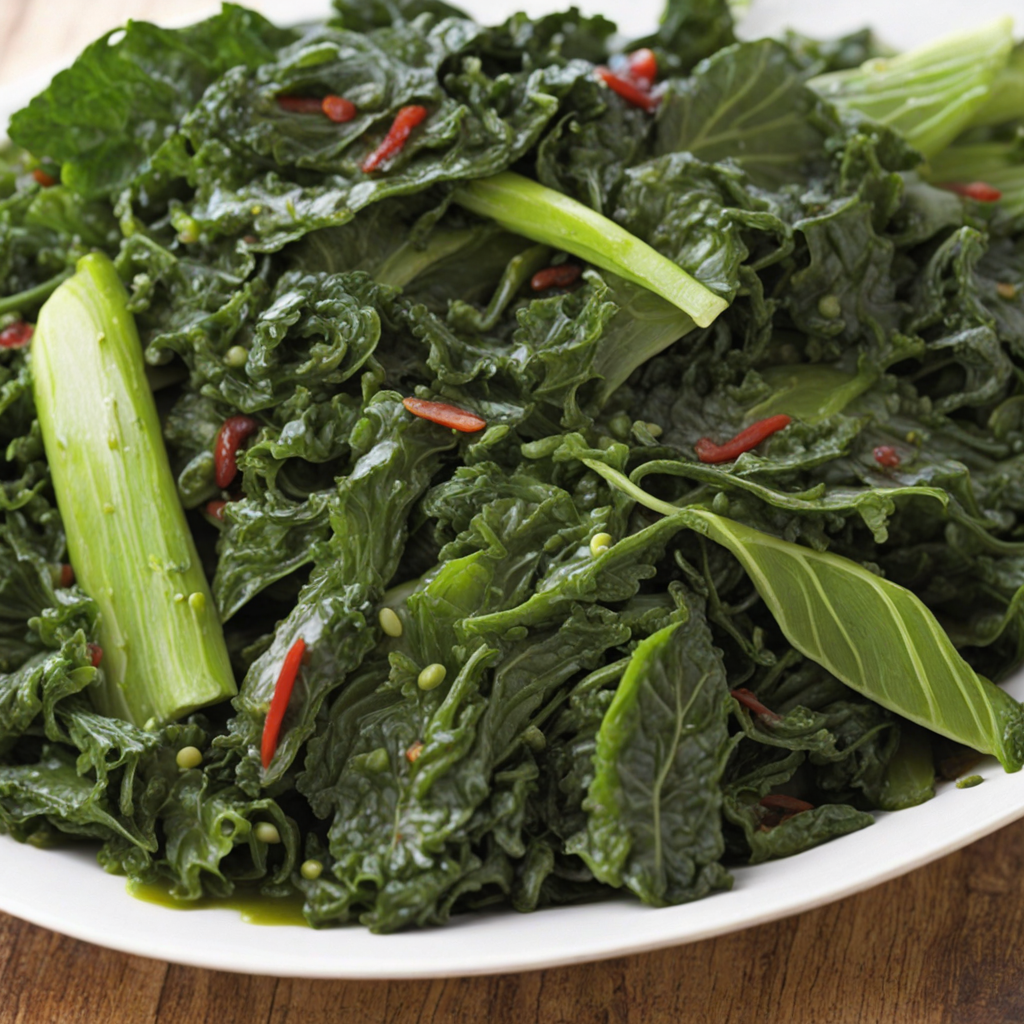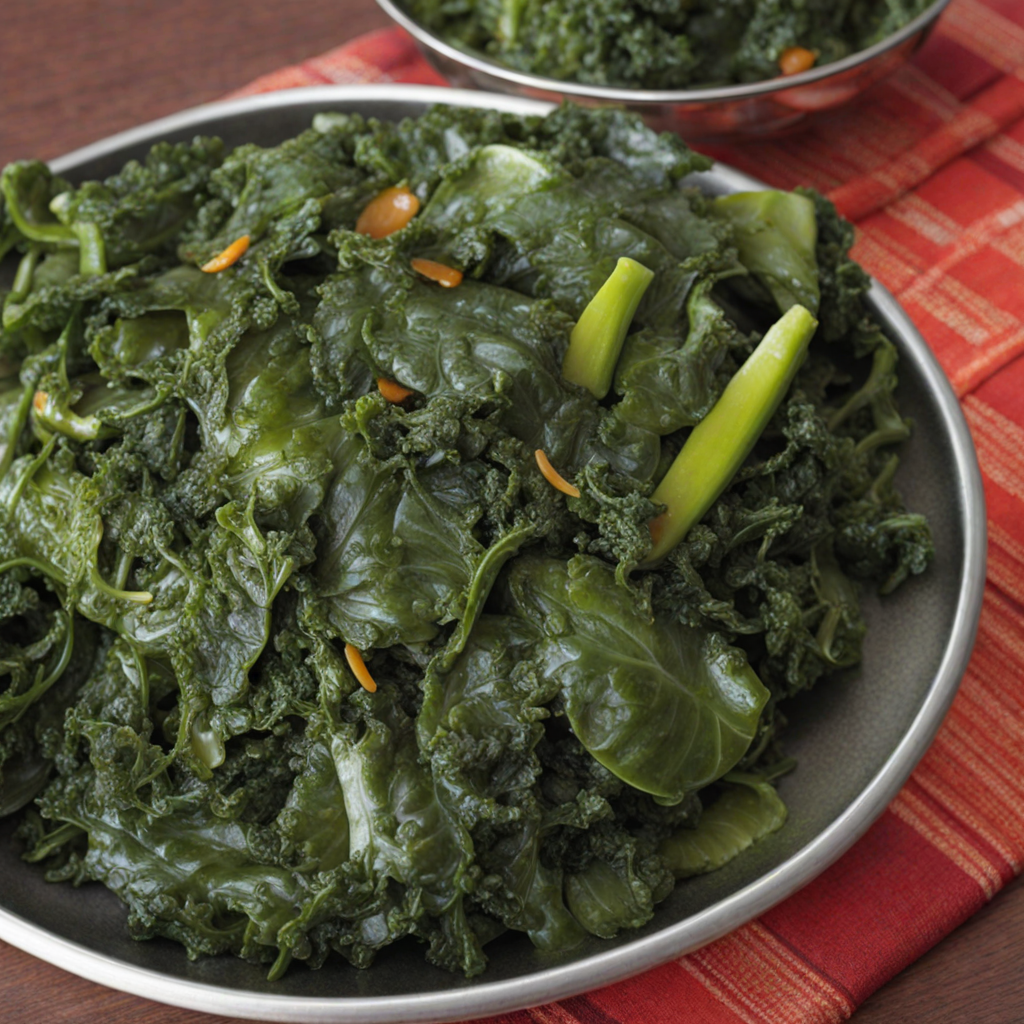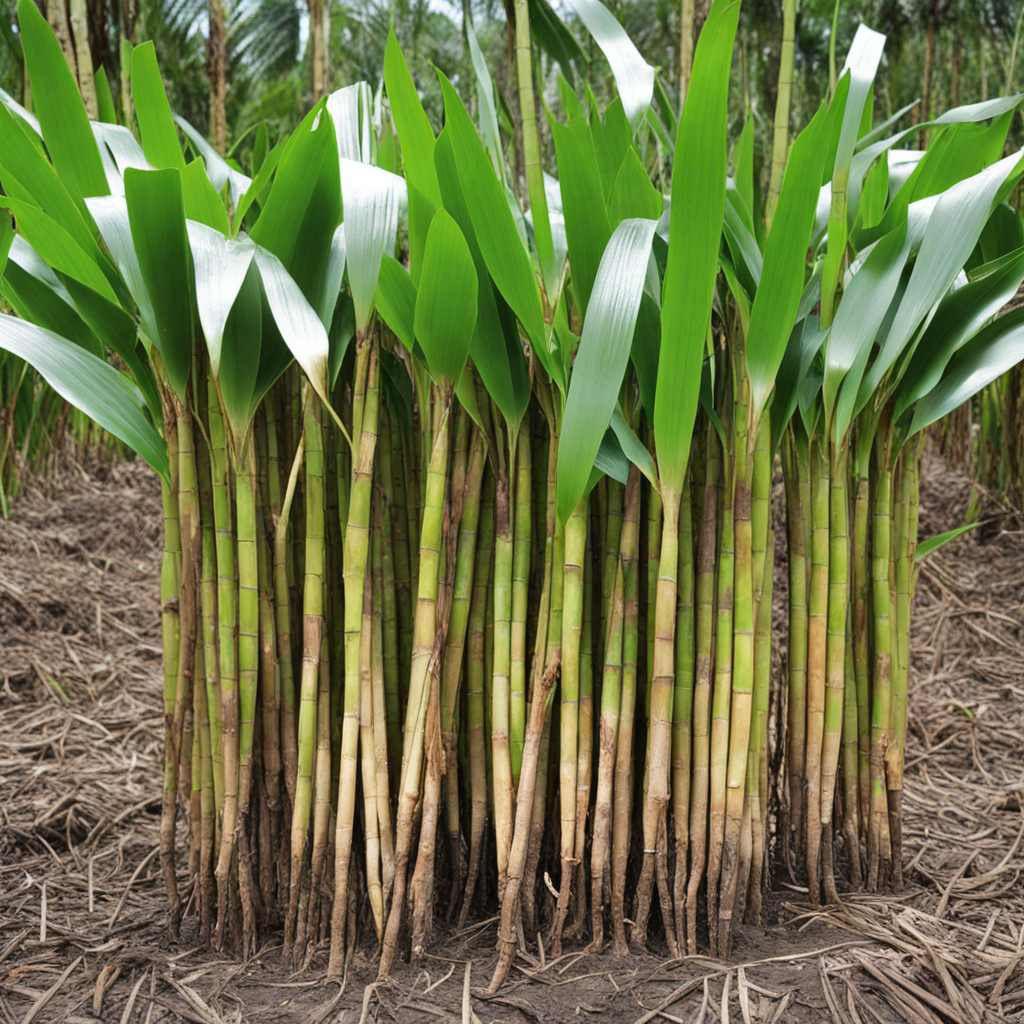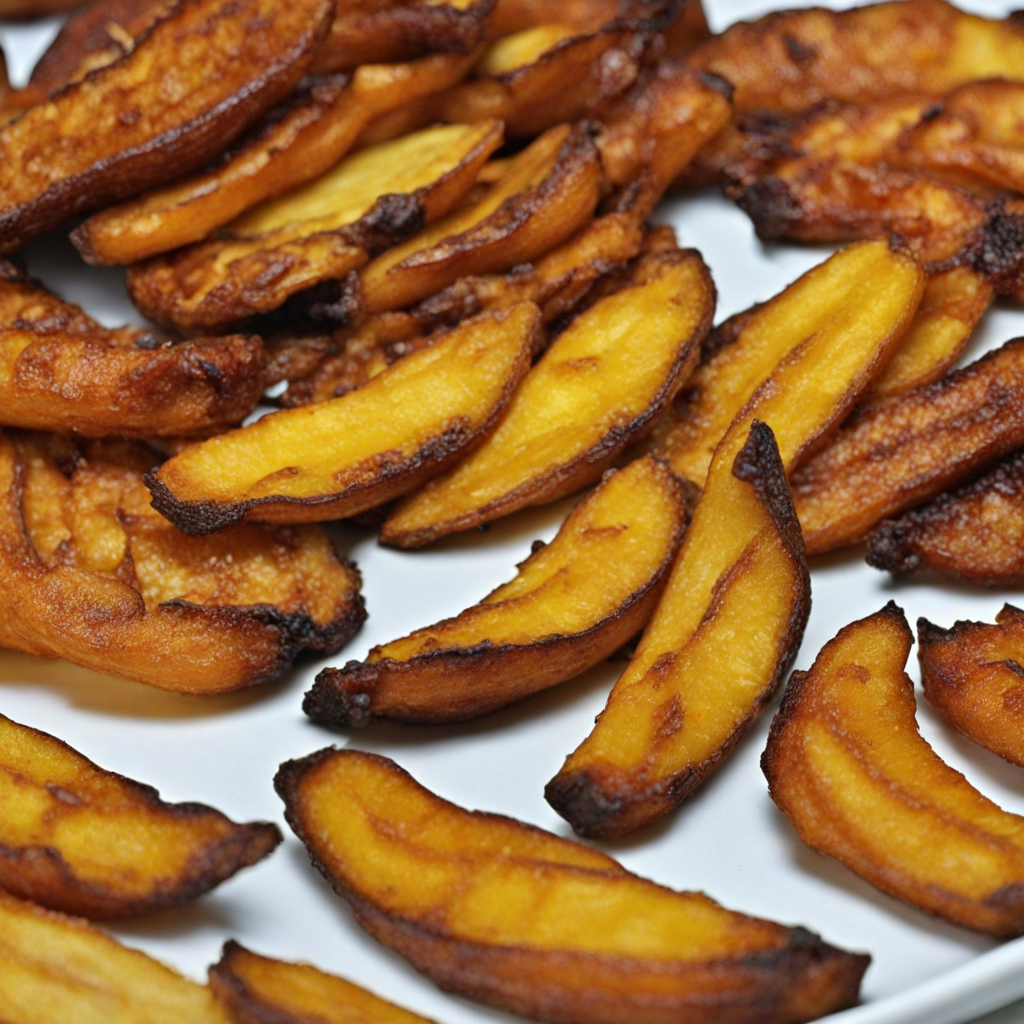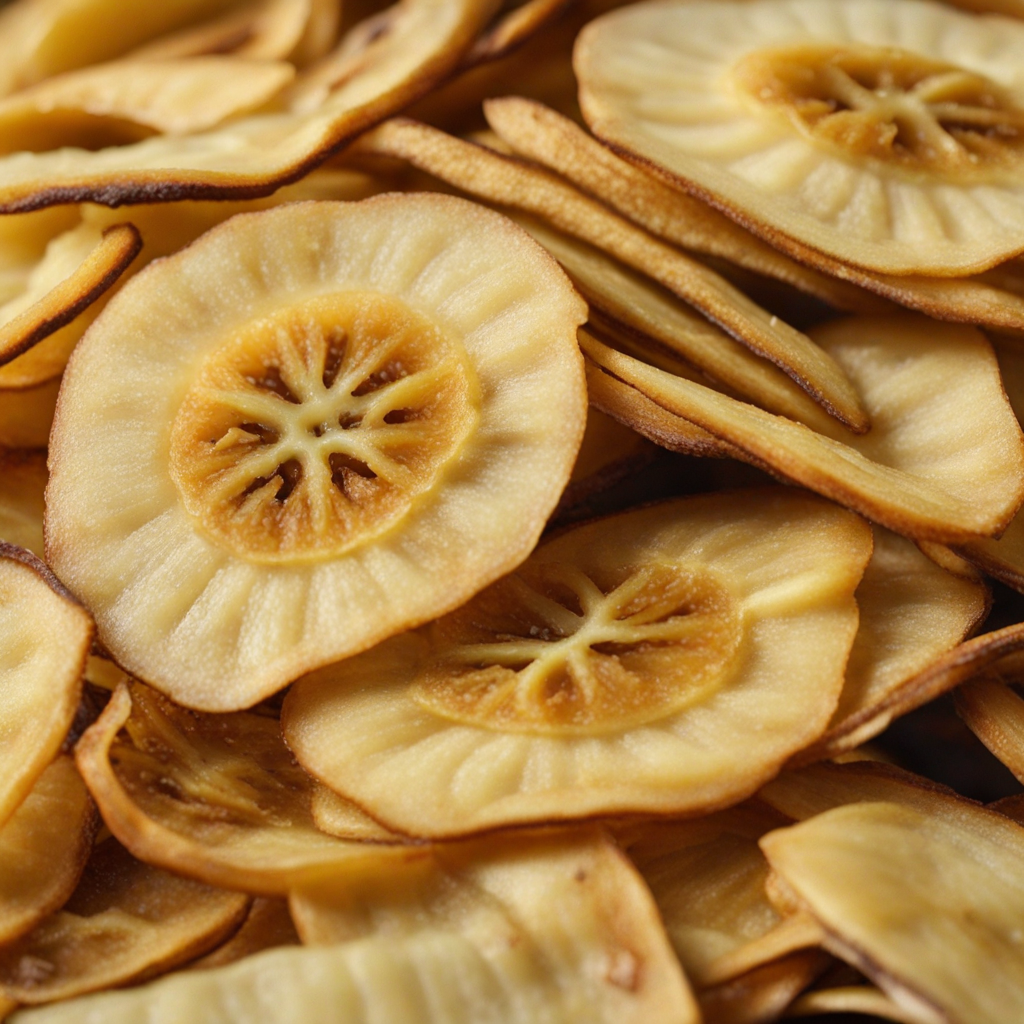Cooked Greens
Cooked greens in Papua New Guinea are a vibrant and essential part of the local cuisine, showcasing the rich biodiversity of the region. These greens, often sourced from wild plants or cultivated varieties, include a range of leafy vegetables such as taro leaves, sweet potato leaves, and various ferns. The preparation typically involves steaming or boiling the greens until tender, allowing their natural flavors to develop while retaining a bright green color. The simplicity of the cooking method highlights the freshness of the ingredients, making them a nutritious and flavorful addition to any meal. To enhance the taste, cooked greens are often seasoned with a touch of salt and sometimes accompanied by coconut cream or a sprinkle of crushed peanuts. The creamy, rich texture of the coconut adds a delightful contrast to the earthiness of the greens, creating a harmonious balance of flavors. In many households, these greens are served alongside staple foods such as taro, cassava, or rice, making for a wholesome and fulfilling dish that reflects the local agricultural practices and dietary preferences. What makes cooked greens particularly unique in Papua New Guinea is the cultural significance they hold. They are commonly featured in communal feasts and are a staple during celebrations, symbolizing abundance and health. The process of gathering wild greens can also be a communal activity, fostering a sense of community and connection to the land. For anyone looking to explore a new culinary experience, tasting cooked greens from Papua New Guinea offers not only a delightful flavor profile but also a glimpse into the rich cultural tapestry of this beautiful country.
How It Became This Dish
Aupa: The Heart of Papua New Guinea's Culinary Heritage Aupa, a traditional dish from Papua New Guinea (PNG), encapsulates the rich tapestry of the country’s diverse cultures, ingredients, and cooking methods. This dish, primarily made from the starchy tuber known as taro, symbolizes more than just sustenance; it represents a profound connection to the land, ancestral traditions, and communal life. #### Origins of Aupa The origins of Aupa can be traced back thousands of years to the indigenous peoples of Papua New Guinea, who have cultivated taro as a staple food for millennia. Taro, known scientifically as *Colocasia esculenta*, thrives in the humid, tropical climates of the Pacific Islands and has been an essential part of the diet in PNG since ancient times. Archaeological evidence suggests that taro was domesticated in Southeast Asia and introduced to the islands well over 3,000 years ago. The name "Aupa" itself is derived from the local languages spoken in PNG, reflecting the diversity of the country’s linguistic landscape. PNG is home to over 800 distinct languages, and Aupa is prepared in various ways depending on the region, each community adding its unique twist to the dish. This regional variation signifies not only the geographic diversity but also the cultural richness that defines Papua New Guinea. #### Cultural Significance Aupa is more than just a dish; it is a symbol of community and tradition. In many PNG cultures, food is central to social life and plays a crucial role in ceremonies, celebrations, and daily interactions. Aupa is often prepared for significant events such as weddings, feasts, and festivals, showcasing the importance of sharing food as a means of fostering relationships and expressing hospitality. The preparation of Aupa typically involves a communal effort, where families and friends come together to harvest taro, peel it, and cook it in an underground oven, known locally as a “mumu.” This method of cooking is not only practical but also imbues the food with a unique flavor that is characteristic of many traditional PNG dishes. The process itself becomes a social event, reinforcing bonds between individuals and emphasizing the value of working together. In the Highlands, Aupa is often served alongside other traditional dishes, such as *Kaukau* (sweet potato) and various types of meat, creating a feast that embodies the agricultural bounty of the region. The dish is also associated with the concepts of reciprocity and sharing; in many communities, it is customary to offer food to guests as a sign of respect and generosity. #### Ingredients and Preparation At its core, Aupa consists of taro, but the dish can incorporate a variety of other ingredients, depending on availability and local customs. Taro is typically boiled or steamed until tender, then mashed or left in chunks. The preparation can be further enhanced with the addition of coconut milk, which adds richness and a subtle sweetness, or with local greens and spices that provide depth and flavor. The process of making Aupa is often steeped in tradition. In some communities, the taro is first baked in hot stones, before being pounded with wooden pestles in large mortars, creating a smooth and creamy texture. This method not only reflects the labor-intensive nature of traditional food preparation but also highlights the skill and artistry involved in creating a dish that is both simple and sublime. #### Development Over Time As Papua New Guinea has evolved, so too has the dish of Aupa. The introduction of modern cooking methods and ingredients has led to new interpretations of this traditional food. Urbanization and globalization have influenced dietary patterns in PNG, with many people now incorporating more processed foods into their diets. However, traditional dishes like Aupa remain integral to the cultural identity of many communities. In recent years, there has been a resurgence of interest in traditional food practices as a response to the challenges posed by modern diets. Many Papua New Guineans are increasingly recognizing the value of their culinary heritage and are seeking to preserve traditional cooking methods and ingredients in the face of globalization. This movement has led to a revival of Aupa in both rural and urban settings, where it is celebrated not only for its taste but also for its cultural significance. Moreover, Aupa has found its way onto the plates of international cuisine enthusiasts, as chefs and food lovers around the world discover the unique flavors of PNG. This has raised awareness of Papua New Guinea's rich culinary traditions, showcasing Aupa as a dish that embodies the spirit of the land and its people. Food festivals and cultural events often feature Aupa, allowing locals and visitors alike to appreciate this unique dish and its connection to the broader narrative of PNG's history and culture. #### Conclusion Aupa is more than just a culinary delight; it is a reflection of the resilience, creativity, and communal spirit of the people of Papua New Guinea. Its rich history, rooted in ancient agricultural practices and cultural traditions, speaks to the importance of food in shaping identity and fostering connections among people. As Papua New Guinea navigates the complexities of modern life, Aupa stands as a testament to the enduring legacy of its culinary heritage, reminding us of the power of food to connect us to our past and to one another. In every bite of Aupa, one can taste the history, culture, and spirit of Papua New Guinea—an invitation to celebrate the beauty of tradition in a rapidly changing world.
You may like
Discover local flavors from Papua New Guinea


